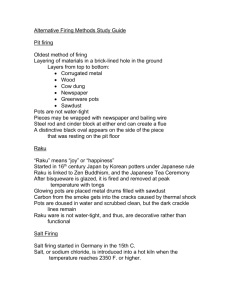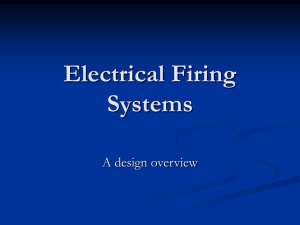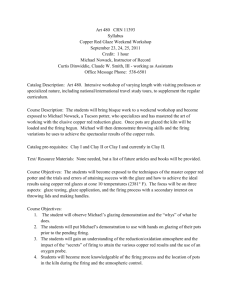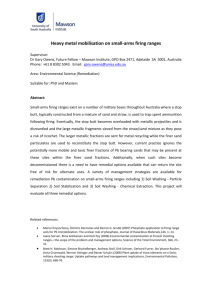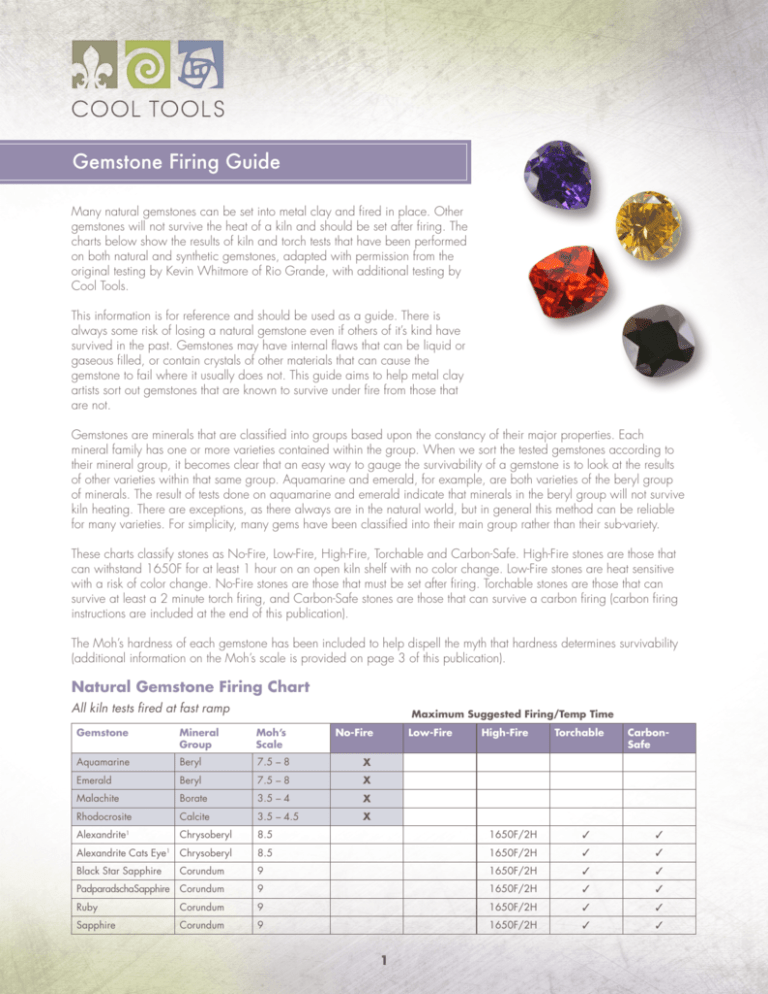
Gemstone Firing Guide
Many natural gemstones can be set into metal clay and fired in place. Other
gemstones will not survive the heat of a kiln and should be set after firing. The
charts below show the results of kiln and torch tests that have been performed
on both natural and synthetic gemstones, adapted with permission from the
original testing by Kevin Whitmore of Rio Grande, with additional testing by
Cool Tools.
This information is for reference and should be used as a guide. There is
always some risk of losing a natural gemstone even if others of it’s kind have
survived in the past. Gemstones may have internal flaws that can be liquid or
gaseous filled, or contain crystals of other materials that can cause the
gemstone to fail where it usually does not. This guide aims to help metal clay
artists sort out gemstones that are known to survive under fire from those that
are not.
Gemstones are minerals that are classified into groups based upon the constancy of their major properties. Each
mineral family has one or more varieties contained within the group. When we sort the tested gemstones according to
their mineral group, it becomes clear that an easy way to gauge the survivability of a gemstone is to look at the results
of other varieties within that same group. Aquamarine and emerald, for example, are both varieties of the beryl group
of minerals. The result of tests done on aquamarine and emerald indicate that minerals in the beryl group will not survive
kiln heating. There are exceptions, as there always are in the natural world, but in general this method can be reliable
for many varieties. For simplicity, many gems have been classified into their main group rather than their sub-variety.
These charts classify stones as No-Fire, Low-Fire, High-Fire, Torchable and Carbon-Safe. High-Fire stones are those that
can withstand 1650F for at least 1 hour on an open kiln shelf with no color change. Low-Fire stones are heat sensitive
with a risk of color change. No-Fire stones are those that must be set after firing. Torchable stones are those that can
survive at least a 2 minute torch firing, and Carbon-Safe stones are those that can survive a carbon firing (carbon firing
instructions are included at the end of this publication).
The Moh’s hardness of each gemstone has been included to help dispell the myth that hardness determines survivability
(additional information on the Moh’s scale is provided on page 3 of this publication).
Natural Gemstone Firing Chart
All kiln tests fired at fast ramp
Maximum Suggested Firing/Temp Time
Gemstone
Mineral
Group
Moh’s
Scale
Aquamarine
Beryl
7.5 – 8
X
Emerald
Beryl
7.5 – 8
X
Malachite
Borate
3.5 – 4
X
Rhodocrosite
Calcite
3.5 – 4.5
X
Alexandrite1
Chrysoberyl
8.5
1650F/2H
3
3
Alexandrite Cats Eye
Chrysoberyl
8.5
1650F/2H
3
3
Black Star Sapphire
1
No-Fire
Low-Fire
High-Fire
Torchable
CarbonSafe
Corundum
9
1650F/2H
3
3
PadparadschaSapphire Corundum
9
1650F/2H
3
3
Ruby
Corundum
9
1650F/2H
3
3
Sapphire
Corundum
9
1650F/2H
3
3
1
Natural Gemstone Firing Chart (continued)
All kiln tests fired at fast ramp
Maximum Suggested Firing/Temp Time
Gemstone
Mineral
Group
Moh’s
Scale
Diamond2
Diamond
10
Almandine Garnet
Garnet
6.5 – 7.5
Demantoid Garnet
Garnet
Pyrope Garnet
Garnet
Rhodolite Garnet
No-Fire
Low-Fire
High-Fire
X
Torchable
CarbonSafe
3
3
1560F/30 min
3
3
6.5 – 7.5
1560F/30 min
3
3
7 – 7.5
1560F/30 min
3
3
Garnet
7 – 7.5
1470F/30 min
3
3
Tsavorite Garnet
Garnet
7 – 7.5
1470F/30 min
3
3
Amazonite
Feldspar
6 – 6.5
1200F/30 min
3
3
Labradorite
Feldspar
6 – 6.5
1200F/30 min
3
Moonstone – Gray
Feldspar
6 – 6.5
1200F/30 min
3
Moonstone – Peach
Feldspar
6 – 6.5
1110F/30 min
3
Moonstone – White
Feldspar
6 – 6.5
1110F/30 min
3
Sunstone
Feldspar
6 – 6.5
1200F/30 min
3
Iolite
Iolite
7 – 7.5
Hematite
Iron Mineral
5.5 – 6.5
1650F/2H
3
3
Zircon
Neosilicate
7.5
1650F/1H
3
3
Olivine
7
3
3
Turquoise
Phosphate
5–6
Chrome Diopside
Pyroxene
5–6
1200F/30 min
Star Diopside
Pyroxene
5–6
1200F/30 min
Jadeite
Quartz
5–6
X
Agate (Cameo)
Quartz
7
X
Amethyst
Quartz
7
X
Aventurine
Quartz
7
X
Black Onyx
Quartz
7
X
Chalcedony
Quartz
7
X
Carnelian
Quartz
7
X
Citrine
Quartz
7
X
Rose Quartz
Quartz
7
X
Rutilated Quartz
Quartz
7
X
Smokey Quartz
Quartz
7
X
Spinel
Spinel
8
Fire Opal
Silicate
6 – 6.5
X
Pyrite4
Sulphide
6 – 6.5
X
Topaz (all varieties)
Topaz
8
X
Green Tourmaline
Tourmaline
7 – 7.5
Pink Tourmaline
Tourmaline
7 – 7.5
Tanzanite
Zoisite
6.5 – 7
Denim Lapis6
Rock
5.5
X
Lapis Lazuli5
Rock
5.5
X
Peridot
3
X
1470F/30 min
X
3
3
1650F/1H
3
3
1200F/30 min
3
X
3
1600F/30 min
See Natural Gemstone Notations on page 3.
2
3
3
Natural Gemstone Notations
Some believe this stone is not available or is too expensive to fire in metal clay. It can be pricey, but there are plenty of sources for this stone, including Cat’s Eye. Loupe the stone before firing. Do not fire if you see what appears to be bubbles in the stone.
2
Diamonds should not be fired on an open kiln shelf. Some very clean stones can be torch fired, but a cloudy stone can result. The safest
method is to fire in activated carbon. See instructions on page 4.
3
Turquoise is a secondary mineral of hydrated copper aluminum phosphate.
4
Pyrite is dangerous in the kiln. Pyrite contains sulphur which can be explosive when heated.
5
Lapis lazuli is not a mineral, but a microcrystaline rock composed mainly of the mineral luzurite, with some pyrite and white calcite.
6
Denim lapis is a low quality lapis with less lazurite and more white calcite.
1
Lab Gemstone & Cubic Zirconia Firing Chart
All kiln tests fired at fast ramp
Maximum Suggested Firing/Temp Time
Gemstone
Mineral
Group
Moh’s
Scale
No-Fire
Low-Fire
High-Fire
Lab Alexandrite
Synthetic
8.5
Lab Emerald1
Synthetic
7.5 – 8
Lab Opal
Synthetic
5.5 – 6
Lab Ruby
Synthetic
9
1650F/2H
3
3
Lab Sapphire
Synthetic
9
1650F/2H
3
3
Lab Sapphire Orange2
Synthetic
9
1650F/1H
3
3
Lab Sapphire Yellow2
Synthetic
9
1650F/1H
3
3
Lab Spinel
Synthetic
9
1650F/2H
3
3
CZ Amethyst
Simulant
8.5 – 9
1650F/2H
3
3
CZ Champagne
Simulant
8.5 – 9
1650F/2H
3
3
CZ Emerald/Bright3
Simulant
8.5 – 9
CZ Garnet
Simulant
8.5 – 9
1650F/2H
3
CZ Jet Black
Simulant
8.5 – 9
CZ Light Amethyst
(Lavender)
Simulant
8.5 – 9
1650F/2H
3
3
CZ Olivine/Dark4
Simulant
8.5 – 9
1650F/1H
3
3
CZ Orange5
(Fire Opal)
Simulant
8.5 – 9
3
3
CZ Pink Sapphire
Simulant
8.5 – 9
1650F/2H
3
3
CZ Tanzanite
Simulant
8.5 – 9
CZ Yellow Diamond
Simulant
8.5 – 9
1650F/2H
3
3
CZ White
Simulant
8.5 – 9
1650F/2H
3
3
CZ Blue Topaz
Simulant
8.5 – 9
X
CZ Alexandrite
Simulant
8.5 – 9
X
CZ Smoked Topaz2
Simulant
8.5 – 9
1650F/2H
3
3
CZ Green Apple
Simulant
8.5 – 9
1650F/2H
Torchable
3
1470F/30 min
CarbonSafe
3
3
X
1110F/10 min
3
1110F/10 min
3
3
1560F/20 min
3
1560F/30 min
Lab Gemstone & Cubic Zirconia Notations
Temperature given is for hydrothermal grown gems.
This stone may darken slightly at 2 hours. The color may become darker, more intense.
3
All bright green CZ’s are extremely oxygen sensitive. Fire at 1110F/10 minutes for any bright green stone, regardless of color name. Carbon firing recommended.
4
CZ’s in the darker olive hue are stable up to 1650F/1H. Lighter olive colors are stable to 2 hours.
5
Orange CZ’s can be fired up to 2 hours at 1650F, but color will fade slightly.
1
2
3
The Moh’s Scale
The Moh’s Scale is a non-linear scale of hardness defined as
resistance to scratching or abrasion.
On the Moh’s scale, 10 represents the hardest material and 1 the
softest. A diamond can scratch another diamond and anything softer
than itself. A corundum can not scratch a diamond, but it can scratch
another corundum and anything softer than itself, and onward down
the scale to talc.
In viewing the Moh’s scale, it would appear that corundum is almost
as hard as a diamond, but the Moh’s scale is deceptive because it
is non-linear. It has steps from 1 to 10, but they are not equal steps.
If we compare the same chart of minerals on an absolute hardness
scale it is apparent that rubies and sapphires (corundum minerals)
are actually 1/4 the hardness of diamond; not 90% as the Moh’s
scale would seem to suggest.
Mineral
Mohs Scale
Absolute
Scale
Diamond
10
1600
Corundum
9
400
Topaz
8
200
Quartz
7
100
Feldspar
6
72
Apatite
5
48
Fluorite
4
21
Calcite
3
9
Gypsum
2
3
Talc
1
1
Carbon-Safe Firing
When looking at the maximum recommended firing time and temperature for a given gemstone, it can be disappointing
to discover that some stones are so sensitive that they can only stand a few minutes at a very low temperature. That means
that some stones can only be embedded in low-fire clays, and if you wanted a very strong product or wanted to use a
clay that required a 2-hour firing, you’d have to select a different gem.
The kiln and torch firing tests conducted on natural, lab and synthetic gemstones were all originally conducted before the
introduction of bronze and copper clays. The gems were tested either by firing them alone in the kiln on an open shelf,
firing the stone alone by torch, or firing a stone embedded in silver clay. So, in every case, oxygen was present during
firing.
The new copper-based bronze and copper clays are buried in activated carbon during firing to avoid the creation of
fire-scale that is difficult to remove from the surface of the fired metal. Fire scale is created when copper is heated in the
presence of oxygen.
Carbon is used as a firing media for copper-based clays because one of its properties is the ability to absorb oxygen.
Since oxygen is the element that causes fire-scale to form when copper alloys are heated, it follows the same theory that
it should also protect gems that are sensitive to oxygen.
4
Firing a Carbon-Safe Stone in Bronze or Copper Clay
Firing gemstones in copper-bearing clays is very simple. Embed your chosen stone in your bronze or copper clay, dry
and fire as usual in activated carbon.
The carbon adsorbs oxygen during firing, and the lack of oxygen protects the stone from burning. Any stone marked as
Carbon-Safe is oxygen-sensitive, but can be safely fired when protected by activated carbon.
Firing a Carbon-Safe Stone in Silver Clays
With this technique, you can safely fire stones in all forms of silver clay at the ideal temperature without sacrificing the
stone or the integrity of the final product.
The method is simple. Pre-burn the binder from the clay before burying it in the activated carbon. The binder must be
burned away first because it will not combust in activated carbon with silver clay present.
To pre-burn the binder, place it on a bed of vermiculite to allow air circulation around the entire piece and ignite it with a
flame. Allow the flame to burn itself out, then turn it over and repeat on the back side to be sure no binder remains. When
igniting the clay, use a flame with no oxygen added to it (such as a standard lighter). A cool flame is needed so the
stones are not overheated during burnout.
After burnout, bury the item in activated carbon and fire at any temperature up to 1650F for your desired hold time.
For a PMC Standard firing, which requires a 2 hour hold time, set your hold time to 2 hours and 30 minutes if you are
using the standard bronze or copper clay firing vessel. The time must be extended as the carbon delays the heat reaching
the interior of the container by 30 minutes.
For PMC PRO firing, no pre-burn is needed. Bury the item in the activated carbon and fire at 1450F for 1 hour.
5
© 2015 Cool Tools | Gemstones3.2015 | All rights reserved | www.cooltools.us | 888.478.5060


